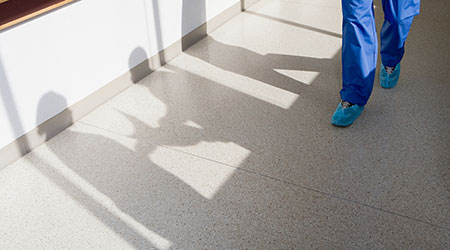Since coronavirus is primarily spread through respiratory droplets, social distancing, mask wearing and hand washing are the common mitigation strategies. However, even though there are less common ways the virus can spread doesn’t mean these methods should be ignored.
Hospital floors have the potential to return to pre-disinfection bacterial levels within several hours after mopping, according to a report titled “From The Floor Up.” Pathogens are consistently introduced to the floor throughout the day by shoes.
A recent interview with Kevin W. Garey, PharmD, MS, FASHP, Professor and Chair of the Department of Pharmacy Practice and Translational Research at University of Houston College of Pharmacy, discusses the threat of shoe-borne pathogens and how quickly they can spread to the entire hospital. For example, with the hospital pharmacy being the hub for the entire facility, an individual transporting medicines also carrying coronavirus can quickly spread the virus throughout the hospital.
Question: You've done an immense amount of research on shoe borne pathogens. Why are hospital floors such a prevalent source of pathogen dissemination, and what makes them different from other high touch surfaces?
Answer from Kevin W. Garey: Any time you’re looking at how a disease spreads, you need to ask, “Why do the organisms spread, what is moving them around, and how often do we clean areas to get rid of the pathogens we put there?” Often, organisms are spread by us stepping on them and moving them around as we walk. That’s why looking at floors is so crucial to infection prevention and control. Because of the square footage of the floor and how highly trafficked it is, you can’t clean it frequently enough, which is often what leads the floor to become a hotbed for pathogen transmission.
In hospitals, viruses are everywhere. That is why handwashing is such an important part of infection prevention protocol. But ask yourself, “When was the last time you gave the bottoms of your shoes a good clean?” Considering that our shoes and floors likely contain more pathogens than other high touch surfaces, like keyboards, door handles, etc., healthcare facilities need to pay particular attention to the role that floors and shoes are playing in their pathogen loads.
We conducted a systematic review of the literature a few years ago, and what we found was notable: It is entirely plausible that air currents, human movements over a contaminated floor, and even the movement of equipment within a room can aerosolize any pathogen on the floor. That creates a risk for human infection via inhalation and cross-contamination from clothing, furniture, or equipment on which it lands. It is something we need to understand better in a COVID-19 world.
Question: Based on your research, as well as what you see in practice today, how can virus migration from shoe soles be mitigated?
Answer: An appreciation of the migration is key. Shoe bottoms can be a source of infection control problems, including coronavirus. In this COVID-19 world, we wear masks, we wash our hands, but we need to also make sure we are focusing on where we walk. This includes doing a regular deep clean of the floors, as well as cleaning the bottoms of our shoes. Fortunately, we now have advancements, like UVC technology, to help us specifically target the migration that occurs as the result of shoe borne pathogens.
One study we completed showed that a UVC device could decontaminate shoe soles effectively, and that represents an important addition to other disinfection strategies. The same study showed that a UVC decontamination device reduced the count of pathogen’s colony-forming units, resulting in a decrease in new colonization on floors, healthcare equipment, furniture, beds, and even the patient’s skin. So, there are ways to mitigate the risk of pathogens carried on shoes.

 Healthcare Real Estate: Challenges and Industry Shifts for 2025
Healthcare Real Estate: Challenges and Industry Shifts for 2025 Geisinger to Build $32 Million Cancer Center in Pennsylvania
Geisinger to Build $32 Million Cancer Center in Pennsylvania Sunflower Medical Group Experiences Data Breach
Sunflower Medical Group Experiences Data Breach Strategies to Eradicate Biofilm Containing C. Auris
Strategies to Eradicate Biofilm Containing C. Auris Man Attacks Nurses, Police Officer at Jefferson Hospital
Man Attacks Nurses, Police Officer at Jefferson Hospital